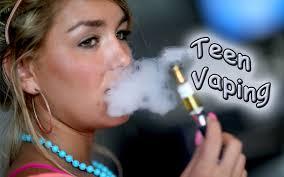 Current e-cigarette use among middle and high school students tripled from 2013 to 2014, according to data published by the Centers for Disease Control and Prevention and the U.S. Food and Drug Administration’s Center for Tobacco Products (CTP). Findings from the 2014 National Youth Tobacco Survey show that current e-cigarette use (use on at least 1 day in the past 30 days) among high school students increased from 4.5 percent in 2013 to 13.4 percent in 2014, rising from approximately 660,000 to 2 million students. Among middle school students, current e-cigarette use more than tripled from 1.1 percent in 2013 to 3.9 percent in 2014—an increase from approximately 120,000 to 450,000 students.
Current e-cigarette use among middle and high school students tripled from 2013 to 2014, according to data published by the Centers for Disease Control and Prevention and the U.S. Food and Drug Administration’s Center for Tobacco Products (CTP). Findings from the 2014 National Youth Tobacco Survey show that current e-cigarette use (use on at least 1 day in the past 30 days) among high school students increased from 4.5 percent in 2013 to 13.4 percent in 2014, rising from approximately 660,000 to 2 million students. Among middle school students, current e-cigarette use more than tripled from 1.1 percent in 2013 to 3.9 percent in 2014—an increase from approximately 120,000 to 450,000 students.
This is the first time since the survey started collecting data on e-cigarettes in 2011 that current e-cigarette use has surpassed current use of every other tobacco product overall, including conventional cigarettes. E-cigarettes were the most used tobacco product for non-Hispanic whites, Hispanics, and non-Hispanic other race while cigars were the most commonly used product among non-Hispanic blacks.
“We want parents to know that nicotine is dangerous for kids at any age, whether it’s an e-cigarette, hookah, cigarette or cigar,” said CDC Director Tom Frieden, M.D., M.P.H. “Adolescence is a critical time for brain development. Nicotine exposure at a young age may cause lasting harm to brain development, promote addiction, and lead to sustained tobacco use.”
Hookah smoking roughly doubled for middle and high school students, while cigarette use declined among high school students and remained unchanged for middle school students. Among high school students, current hookah use rose from 5.2 percent in 2013 (about 770,000 students) to 9.4 percent in 2014 (about 1.3 million students).
The increases in e-cigarette and hookah use offset declines in use of more traditional products such as cigarettes and cigars. There was no decline in overall tobacco use between 2011 and 2014. Overall rates of any tobacco product use were 24.6 percent for high school students and 7.7 percent for middle school students in 2014.
“In today’s rapidly evolving tobacco marketplace, the surge in youth use of novel products like e-cigarettes forces us to confront the reality that the progress we have made in reducing youth cigarette smoking rates is being threatened,” said Mitch Zeller, J.D., director of FDA’s Center for Tobacco Products. “These staggering increases in such a short time underscore why FDA intends to regulate these additional products to protect public health.”
This report concludes that further reducing youth tobacco use and initiation is achievable through regulation of the manufacturing, distribution, and marketing of tobacco products coupled with proven strategies. Several states have passed laws establishing a minimum age for purchase of e-cigarettes or extending smoke-free laws to include e-cigarettes, both of which could help further prevent youth use and initiation.
For broadcast-quality video and audio clips featuring FDA’s Center for Tobacco Products Director Mitch Zeller speaking about the findings from the 2014 National Youth Tobacco Survey, visit http://dmr.homefrontdc.com/697/ctp-nyts-findings.

 A significant number of parents are not allowing their daughters to receive the
A significant number of parents are not allowing their daughters to receive the